 Are you planning to go for an outing to Pink City, but concerned about the transportation, sightseeing? Here, we at Jaipur Sightseeing Taxi or Car Rental Company provide you with a one-stop solution to satisfy all your travel needs. From a huge collection of cars, you can select any vehicle as per your needs and requirements. We have large fleet of luxury cars and vehicles like standard cars, deluxe cars, semi deluxe cars, luxury cars, semi-luxury cars, minivan etc. We at PINKCITY CABS provide chauffeur driven car rental services at very affordable and economical rate. Get ready to enjoy local sightseeing tour – Check our special offer for Jaipur Sightseeing, a very happening thing that includes journey through the historic forts, temples, gardens and the palaces of the city.
Are you planning to go for an outing to Pink City, but concerned about the transportation, sightseeing? Here, we at Jaipur Sightseeing Taxi or Car Rental Company provide you with a one-stop solution to satisfy all your travel needs. From a huge collection of cars, you can select any vehicle as per your needs and requirements. We have large fleet of luxury cars and vehicles like standard cars, deluxe cars, semi deluxe cars, luxury cars, semi-luxury cars, minivan etc. We at PINKCITY CABS provide chauffeur driven car rental services at very affordable and economical rate. Get ready to enjoy local sightseeing tour – Check our special offer for Jaipur Sightseeing, a very happening thing that includes journey through the historic forts, temples, gardens and the palaces of the city. 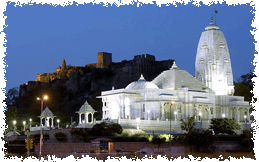 The Birla Temple, originally known as Lakshmi Narayan Temple, and is situated below the well known Moti Dungri fort, Jaipur. This temple forms one of the major attractions of Jaipur. Birla Temple of Jaipur looks stunning, when it is brightly lit in the night. The enormous temple was built during the year 1988, by Birla Group of Industries, one of the business tycoons of India. The Temple is dedicated to Lord Vishnu (Narayan), the preserver and his consort Lakshmi, the Goddess of wealth. Built in pure white marble, the Birla Temple is unlike the traditional ancient Hindu temples, and is built with a modern approach. The three huge domes of the temple represent three different approaches to the religion. The beautiful white marble temple mesmerizes the onlookers, when it glows at night. Stained glass widows depict the scenes from Hindu scriptures. Ganesh the protector of households, is above the lintel, and the fine quality of marble is evident when you enter the temple and look back at the entrance way. The images of Lakshmi and Narayan attract the attention, being made out from one piece of marble. Many of the deities of the Hindu pantheon are depicted inside the temple, and on the outside walls great historical personages and figures from all religions are shown, including Socrates, Zarathustra, Christ, Budhda, and Confucius. The Laxmi Narayan Mandir is a modern architectural marvel, surrounded by lush green gardens. The fascinating exteriors of the temple are carved splendidly with beautiful sculptures based of mythological themes, while the interiors have a large marble panel portraying mythological events.
The Birla Temple, originally known as Lakshmi Narayan Temple, and is situated below the well known Moti Dungri fort, Jaipur. This temple forms one of the major attractions of Jaipur. Birla Temple of Jaipur looks stunning, when it is brightly lit in the night. The enormous temple was built during the year 1988, by Birla Group of Industries, one of the business tycoons of India. The Temple is dedicated to Lord Vishnu (Narayan), the preserver and his consort Lakshmi, the Goddess of wealth. Built in pure white marble, the Birla Temple is unlike the traditional ancient Hindu temples, and is built with a modern approach. The three huge domes of the temple represent three different approaches to the religion. The beautiful white marble temple mesmerizes the onlookers, when it glows at night. Stained glass widows depict the scenes from Hindu scriptures. Ganesh the protector of households, is above the lintel, and the fine quality of marble is evident when you enter the temple and look back at the entrance way. The images of Lakshmi and Narayan attract the attention, being made out from one piece of marble. Many of the deities of the Hindu pantheon are depicted inside the temple, and on the outside walls great historical personages and figures from all religions are shown, including Socrates, Zarathustra, Christ, Budhda, and Confucius. The Laxmi Narayan Mandir is a modern architectural marvel, surrounded by lush green gardens. The fascinating exteriors of the temple are carved splendidly with beautiful sculptures based of mythological themes, while the interiors have a large marble panel portraying mythological events.
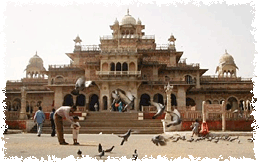 Albert Hall museum is situated in Ram Niwas Garden outside the city wall opposite new gate and is a fine example of Indo-Saracenic architecture. It is the oldest museum of the state and functions as the State museum of Rajasthan. The building was designed by Sir Samuel Swinton Jacob and was opened as public museum in 1887. It is also called the Government Central Museum. Maharaja Ram Singh initially wanted this building to be a town hall, but his successor, Madho Singh II, decided it should be a museum for the art of Jaipur and included as part of the new Ram Nivas Garden. The museum has a rich collection of artefacts like paintings, carpets, ivory, stone, metal sculptures, colourful crystal works etc.
Albert Hall museum is situated in Ram Niwas Garden outside the city wall opposite new gate and is a fine example of Indo-Saracenic architecture. It is the oldest museum of the state and functions as the State museum of Rajasthan. The building was designed by Sir Samuel Swinton Jacob and was opened as public museum in 1887. It is also called the Government Central Museum. Maharaja Ram Singh initially wanted this building to be a town hall, but his successor, Madho Singh II, decided it should be a museum for the art of Jaipur and included as part of the new Ram Nivas Garden. The museum has a rich collection of artefacts like paintings, carpets, ivory, stone, metal sculptures, colourful crystal works etc.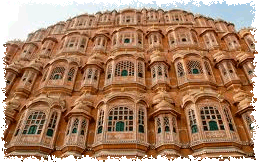 Hawa Mahal or Palace of Winds is a palace in Jaipur, Rajasthan. It was built in 1799 by Maharaja Sawai Pratap Singh, and designed by Lal Chand Ustad in the form of the crown of Krishna, the Hindu god. Its unique five-storey exterior is also akin to the honeycomb of the beehive with its 953 small windows called jharokhas that are decorated with intricate latticework. The original intention of the lattice was to allow royal ladies to observe everyday life in the street below without being seen, since they had to observe strict "purdah" (face cover).
Hawa Mahal or Palace of Winds is a palace in Jaipur, Rajasthan. It was built in 1799 by Maharaja Sawai Pratap Singh, and designed by Lal Chand Ustad in the form of the crown of Krishna, the Hindu god. Its unique five-storey exterior is also akin to the honeycomb of the beehive with its 953 small windows called jharokhas that are decorated with intricate latticework. The original intention of the lattice was to allow royal ladies to observe everyday life in the street below without being seen, since they had to observe strict "purdah" (face cover).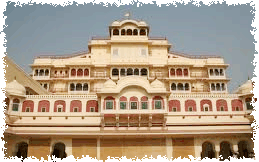 City Palace, Jaipur, which includes the Chandra Mahal and Mubarak Mahal palaces and other buildings, is a palace complex in Jaipur. It was the seat of the Maharaja of Jaipur, the head of the Kachwaha Rajput clan. The Chandra Mahal palace now houses a museum but the greatest part of it is still a royal residence. The palace complex, which is located northeast of the centre of the grid patterned Jaipur city, incorporates an impressive and vast array of courtyards, gardens and buildings. The palace was built between 1729 and 1732, initially by Sawai Jai Singh II, the ruler of Amber. He planned and built the outer walls, and later additions were made by successive rulers’ right up to the 20th century. The credit for the urban layout of the city and its structures is attributed to two architects namely, Vidyadar Bhattacharya, the chief architect in the royal court and Sir Samuel Swinton Jacob, apart from the Sawai himself who was a keen architectural enthusiast. The architects achieved a fusion of the Shilpa Shastra of Indian architecture with Rajput, Mughal and European styles of architecture.
City Palace, Jaipur, which includes the Chandra Mahal and Mubarak Mahal palaces and other buildings, is a palace complex in Jaipur. It was the seat of the Maharaja of Jaipur, the head of the Kachwaha Rajput clan. The Chandra Mahal palace now houses a museum but the greatest part of it is still a royal residence. The palace complex, which is located northeast of the centre of the grid patterned Jaipur city, incorporates an impressive and vast array of courtyards, gardens and buildings. The palace was built between 1729 and 1732, initially by Sawai Jai Singh II, the ruler of Amber. He planned and built the outer walls, and later additions were made by successive rulers’ right up to the 20th century. The credit for the urban layout of the city and its structures is attributed to two architects namely, Vidyadar Bhattacharya, the chief architect in the royal court and Sir Samuel Swinton Jacob, apart from the Sawai himself who was a keen architectural enthusiast. The architects achieved a fusion of the Shilpa Shastra of Indian architecture with Rajput, Mughal and European styles of architecture.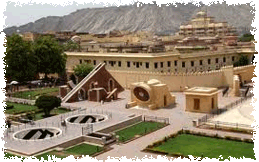 Jantar Mantar is a major tourist attraction in Jaipur that lures tourist from all over the world. The Jantar Mantar is a collection of architectural astronomical instruments, built by Maharaja (King) Jai Singh II at his then new capital of Jaipur between 1727 and 1734, Jantar mantar means ‘calculation instrument’, it’s also belongs to Jyotisa. The observatory consists of fourteen major geometric devices (or yantras in Hindi) for measuring time, predicting eclipses, tracking stars in their orbits, ascertaining the declinations of planets and determining the celestial altitudes etc.
Jantar Mantar is a major tourist attraction in Jaipur that lures tourist from all over the world. The Jantar Mantar is a collection of architectural astronomical instruments, built by Maharaja (King) Jai Singh II at his then new capital of Jaipur between 1727 and 1734, Jantar mantar means ‘calculation instrument’, it’s also belongs to Jyotisa. The observatory consists of fourteen major geometric devices (or yantras in Hindi) for measuring time, predicting eclipses, tracking stars in their orbits, ascertaining the declinations of planets and determining the celestial altitudes etc.
Jantar Mantar is located close to the gate of the famous City Palace of Jaipur. The huge masonry instruments were used to study the movement of constellations and stars in the sky. Really it’s a very amazing architectural astronomical instruments, its designed with a special aim and its shape and setting also a very scientifically.
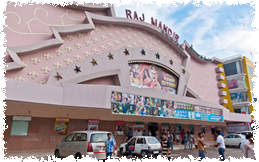 Raj Mandir Cinema is a famous movie theater in Jaipur, situated on the Bhagwan Das Road, near M.I. Road, the meringue-shaped auditorium opened in 1976, and over the years has seen many movie premieres of Hindi films, and has become a popular symbol of Jaipur, it is often referred as the Pride of Asia.
Raj Mandir Cinema is a famous movie theater in Jaipur, situated on the Bhagwan Das Road, near M.I. Road, the meringue-shaped auditorium opened in 1976, and over the years has seen many movie premieres of Hindi films, and has become a popular symbol of Jaipur, it is often referred as the Pride of Asia.
 Raja Man Singh built Amer Palace in 16th century. It is a mesmerizing blend of Hindu and Mughal architecture. Rajputs made use of this Amber Fort from the 16th century up to the foundation of Jaipur in 1727. The Amber Fort was used by the Rajputs both for defense purpose as well as the residential purposes. Thus within its mighty walls, one finds charming gardens and magnificent palaces made from marble and precious stones, richly decorated with intricate stonemason works and paintings, which represented royal splendor and luxury.
Raja Man Singh built Amer Palace in 16th century. It is a mesmerizing blend of Hindu and Mughal architecture. Rajputs made use of this Amber Fort from the 16th century up to the foundation of Jaipur in 1727. The Amber Fort was used by the Rajputs both for defense purpose as well as the residential purposes. Thus within its mighty walls, one finds charming gardens and magnificent palaces made from marble and precious stones, richly decorated with intricate stonemason works and paintings, which represented royal splendor and luxury. 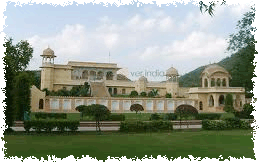 Kanak Vrindavan is an exceptionally beautiful garden located at the foot hills of Nahargarh, in the manmade oasis of Kanak valley. Almost 280 years ago, Kanak Vrindavan was apellated by Maharaja Sawai Jai Singh, who was the founder of Jaipur. He found the beauty of this valley quite similar to that of the sanctum of Lord Krishna in Vrandavan.
Kanak Vrindavan is an exceptionally beautiful garden located at the foot hills of Nahargarh, in the manmade oasis of Kanak valley. Almost 280 years ago, Kanak Vrindavan was apellated by Maharaja Sawai Jai Singh, who was the founder of Jaipur. He found the beauty of this valley quite similar to that of the sanctum of Lord Krishna in Vrandavan.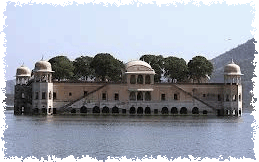 Jal Mahal (meaning "Water Palace" ) is a palace located in the middle of the Man Sagar Lake in Jaipur city, the capital of the state of Rajasthan, India. The palace and the lake around it were renovated and enlarged in the 18th century by Maharaja Jai Singh II of Amber. The Jal Mahal has got an eye-popping makeover. Traditional boat-makers from Vrindavan have crafted the Rajput style wooden boats. A gentle splashing of oars on the clear lake waters takes you to Jal Mahal. You move past decorated hallways and chambers on the first floor to climb all the way up to the fragrant Chameli Bagh. Across the lake, you can view the Aravalli hills, dotted with temples and ancient forts, and on the other side, bustling Jaipur. The most remarkable change is in the lake itself. The drains were diverted, two million tonnes of toxic silt were dredged from the bottom, increasing its depth by over a metre, a water treatment system was developed, local vegetation and fish reintroduced, the surrounding wetlands regenerated and five nesting islands created to attract migratory birds.
Jal Mahal (meaning "Water Palace" ) is a palace located in the middle of the Man Sagar Lake in Jaipur city, the capital of the state of Rajasthan, India. The palace and the lake around it were renovated and enlarged in the 18th century by Maharaja Jai Singh II of Amber. The Jal Mahal has got an eye-popping makeover. Traditional boat-makers from Vrindavan have crafted the Rajput style wooden boats. A gentle splashing of oars on the clear lake waters takes you to Jal Mahal. You move past decorated hallways and chambers on the first floor to climb all the way up to the fragrant Chameli Bagh. Across the lake, you can view the Aravalli hills, dotted with temples and ancient forts, and on the other side, bustling Jaipur. The most remarkable change is in the lake itself. The drains were diverted, two million tonnes of toxic silt were dredged from the bottom, increasing its depth by over a metre, a water treatment system was developed, local vegetation and fish reintroduced, the surrounding wetlands regenerated and five nesting islands created to attract migratory birds.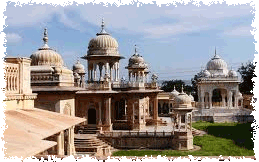
Gaitor is located to the west of the road to Amber in a valley, which is 15 km from the pink city. This royal crematory is popular for the cenotaphs of the rulers of Jaipur. All the cenotaphs of rulers have delicate carvings. Take a look at the impressive cenotaph of Maharajah Jai Singh II built with white marble and peacock carving. Maharani Ki Chhatri with the memorials of queens is located near the Ramgarh road crossing. Gaitor in Jaipur with cenotaphs and memorials is at the foothills of the Nahargarh Fort. The royal Gaitor in Jaipur has cenotaphs or chhatris in the memory of royal family of Jaipur. This royal crematorium is a place where the rulers of Jaipur ended their life journey. The cenotaph of Sawai Ishwari Singh is outside the Jai Niwas Garden. From the year 1733, royal Gaitor ground was used for cremation of Kachhwaha kings. Every cenotaph has distinct design. The chhatri or cenotaph of Madho Singh II is built with white and pink stone.




